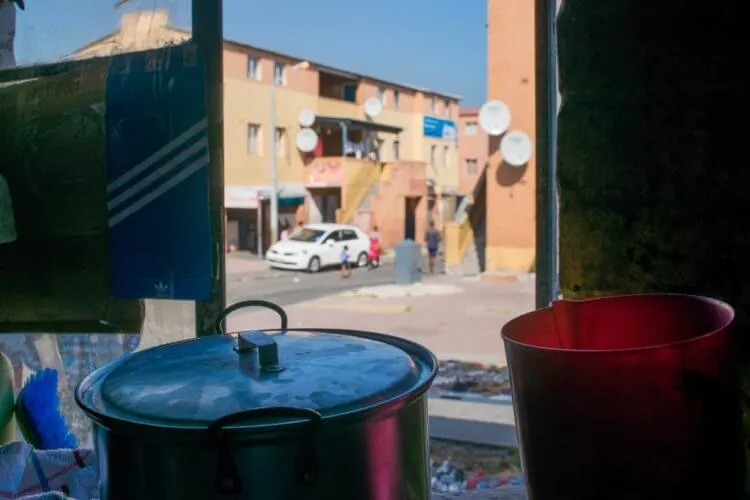A Cape Town Townships Tour: Langa and Khayelitsha (Photo Journal)
As the very first part of my 40 day overland African tour, we did a Cape Town Townships Tour. I wasn’t all too familiar with the social and political situations down here when I arrived, so it was definitely an interesting and eye-opening experience in my first few days here. (Photos at end)
A township is an area that was created for people of color to live in during the period of government-enforced apartheid last century. As I currently understand it, South Africa was first colonized by the Dutch, then the English. It was at first a place of strong racial coexistence, and before our Cape Town townships tour we visited an area called District 6 where all races used to live together (Cape Town was divided into 9 districts at that point.)
In the 1900’s, the government started enforcing an apartheid rule, which banned any integration of the races. They mandated that people of color live together in these townships, which ended up very densely populated and impoverished. It wasn’t until 1994 that this was finally abolished… NINETEEN NINETY FOUR. So, not long ago at all. This is when Nelson Mandela was released from prison and came into power, finally uniting the people of South Africa who had been fighting for equality for decades.
Anyway, now that we have had a little background info and history lesson… these townships still exist today. There is still a lot of poverty, but the government is doing a lot to make sure everyone has a place to live. This is how my day went in the township!
Our Cape Town Townships Tour
The township we visited was called Langa. There is a pretty wide variety of accommodation here – from newly renovated flats to actual shacks made from metal sheets. Most are shared living. Some of the places were actually reserved only for working men to live until the mid-80’s – and as many as three would share a room.
When wives and families finally had enough and demanded to live with their husbands, they would have to share the same beds and shared housing – like, three families in three beds in one room. Many would have to use the living room to sleep.
Book a Cape Town Townships Tour like Mine
I was at first really unsure about waltzing around the place these people live, as a tourist, toting my fancy camera and intruding on their personal lives for my own experience. I felt a bit awkward wandering about their houses, looking at a cramped-to-the-brim room as one lady hand-washed laundry in the common room and another boiled a kettle. I felt almost guilty, as a privileged traveler able to make it to their country to witness their less than ideal way of life.
But honestly, I have never met anyone so welcoming.
Each person welcomed us with a genuine smile that seemed to really see down to your soul. Children waved at us as we went by, and our hi’s were met with equally enthusiastic hello’s. As time went on, we started to be much less uneasy about the situation, and started interacting with more of the locals walking by.
Kids gathered to kick a soccer ball around, or to play with little bits of trash. There were little makeshift barber shops, stores selling all different things, and salons with spray-painted signs.
Our guide told us about how the housing works – certain housing is free, some is free for a certain time while the tenant obtains a job, some is for a minimal rent, and some is more expensive. People around here are very entrepreneurial, making jewelry to sell, fixing shoes or roofs, washing cars, or selling different kinds of food to make money.
There were tons of lots being built on, with many more government projects in progress to build more free housing so that the people in the roughest part of town, living in the loosely constructed metal/wooden shacks, could have a home.
The situation was heartbreaking, it really was. But I strangely felt heartwarming at the same time as heartbreak. These people’s smiles, the fact that they were happy like this, making the most of the situation, homeless but still with an iron-strong sense of community and belonging… it warmed my heart as well. They were living with nothing, but still sitting together on overturned empty crates and enjoying home-brewed beer and good music together.
I could tell that music was also a massive factor in the happiness of the township. There was music blasting from every house, and people danced as they walked along the streets. You couldn’t go far without hearing a new song playing from somewhere, with someone somewhere singing along.
It’s a hard yet inevitable part of traveling to experience poverty and difficulty. It’s hard to know what to do when you encounter it. Giving money is one thing, but it doesn’t directly solve the problems and there’s no way to know where it goes.
Subscribe to Adventures & Sunsets!
Each month I send out an update with the month’s most fascinating content, best travel deals and products, fun facts, best photos, and where we’ve been. Join me!OKAY I’M IN!I consent to receiving emails and personalized ads.
You can buy their trinkets, maybe, on the side of the road. It’s one thing to smile at them, to talk with them, to try to understand where they are coming from and what their life is about, and ask about their hopes and dreams. I think the biggest thing to do is spread the word – ensure that their situation is known and it is cared about. Knowledge truly is power, and travel is the best teacher of all.

